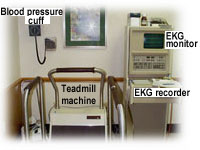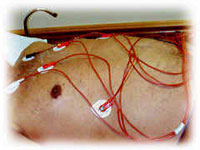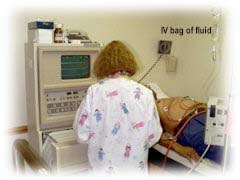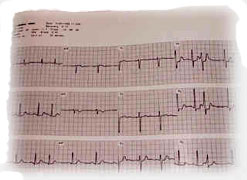Your on-line source for reliable and unbiased information about the evaluation & treatment of heart disease.
Patients with coronary artery blockages may have minimal symptoms and an unremarkable or unchanged EKG while at rest. Alternatively, patients with no heart disease may have fairly convincing symptoms and a suspicious EKG. Both groups may benefit from a cardiac stress test during which exercise or a chemical substance is used to stress the heart and expose hidden heart disease or to help rule it out. .
The heart may be stressed by having a patient exercise on a treadmill or a stationary bicycle. If the patient is unable to exercise secondary to physical limitations such as severe arthritis, artificial limbs, generalized weakness, paralysis, unsteady gait, etc., the physician may choose a pharmacological or chemical form of test. In the latter case, a medication is given intravenously to perform a nearly comparable degree of cardiac stress. If possible, some form of pharmacological stress testing may be combined with a brief period of treadmill exercise.
Stress testing, particularly those employing exercise, help reveal the following:
- The length of exercise demonstrates physical tolerance and conditioning.
- Extreme and inappropriate shortness of breath, chest discomfort, dizziness and unexpected weakness may suggest underlying heart disease.
- The blood pressure is recorded at intervals during stress (in the beginning and usually at three minute intervals, if stable). It may be checked more frequently if the patient's blood pressure response to exercise is abnormal.
- High blood pressure during exercise may provide an early clue or indication about this problem. Normally, the systolic (upper reading) blood pressure may rise up to 200 during extreme or peak exercise, while the diastolic (lower reading) remains below 90. Patients with inadequately controlled high blood pressure usually display high diastolic readings during exercise.
- A drop in blood pressure during exercise may indicate heart disease.
- Exercise may provoke arrhythmias (pronounced a-rhyth-me-yaz) or irregular heart rhythm which may not be seen at rest and may or may not point to heart disease.
- The EKG is constantly monitored during exercise and recorded on paper at intervals (usually every minute) and compared to the EKG obtained at rest. Changes in the ST segment and T waves may indicate heart disease.


The equipment in a typical cardiac stress test lab is demonstrated above (left). The picture shows a treadmill. However, some labs may be equipped with a stationary bicycle. The EKG monitor and paper recorder plus the blood pressure cuff is also shown. The RISK of cardiac stress testing is very small. However, since it is carried out in patients with known or suspected heart disease, almost every lab is also equipped with emergency cardiac drugs and resuscitative equipment. It is emphasized that these are precautionary measures that are rarely needed.
PREPARATION: Do not eat three hours before the test. However, it is acceptable to use small amounts of liquid, particularly if it is needed with medications. A heavy meal prior to stress testing may cause nausea, and is discouraged. Depending upon the time of the day that the stress test is conducted, diabetics will need special instructions about the use and dose of insulin. Also check with your doctor's office about taking your usual medications before the test. Specific medications may be held for 24 hours prior to the test to achieve more accurate results.
Wear comfortable clothes and walking shoes or sneakers that would be suitable for exercise.
A trained technician or nurse will place small sticky patches on your chest. These are known as electrodes and are attached to wires that transmit the electrical activity of your heart to the EKG monitor and recorder. A wrap may be placed around your waist to hold the cables in place.


An EKG is then recorded on paper. This is known as the RESTING EKG and serves as a baseline. Additional recordings will be made during and following exercise. The physician will pay particular attention to changes in the pattern of the EKG (ST segments and T waves, heart rate, and the presence of an abnormal heart rhythm).
During stress testing, the heart rhythm is constantly displayed on a heart monitor. This allows the physician to keep an eye on the patient's heart rate, and to watch out for telltale EKG changes and irregular heart rhythm.
When a treadmill or stationary bicycle stress testing is conducted, it is continued until the patient achieves a target heart rate (based upon age). However, it may be stopped early if the patient develops significant symptoms (chest pain, extreme shortness of breath, weakness, leg fatigue, dizziness, etc.), serious irregular heart rhythm or marked elevation of blood pressure. It is emphasized the majority of patient's do not develop these problems. Fatigue, as would be expected after a good workout, is the only residual complaint.
![]()
©1999-2017, 20XXA.S.M. Systems, Inc. All Rights Reserved, including design and all graphic contents & animations